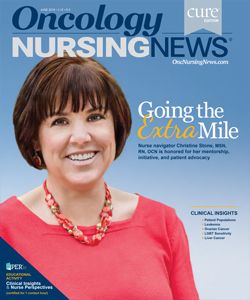Managing Cancer Pain in an Era of Opioid Abuse
Government efforts to decrease unnecessary opioids use and reduce opioid diversion are creating a worrisome impact on cancer pain management.
Lisa Schulmeister, MN, RN, FAAN

Lisa Schulmeister, MN, RN, FAAN
Opioid addiction is being called an epidemic and public health crisis in the United States. In response, the CDC issued guidelines for prescribing opioids that have been widely adopted. In addition, the federal government and many state legislatures have introduced or enacted laws on opioid abuse prevention and treatment. Generally, legislation includes prescription drug monitoring and restrictions on dosages and amount dispensed. In many states, opioid prescriptions are limited to 3- to 7-day supplies. These efforts are intended to decrease the unnecessary use of opioids and reduce opioid diversion; however, their impact on cancer pain management is worrisome.
Years ago, the undertreatment of pain was a reality for many individuals with cancer. Fortunately, over the years, the complexity of pain was acknowledged and addressed. It’s now known that cancer pain can involve inflammatory, neuropathic, ischemic, and compression mechanisms at multiple sites. Pain also can be triggered by adverse effects of cancer treatment, such as mucositis, arthralgia, and neuropathies. The introduction of new analgesics in improved formulations such as extended release, as well as advanced delivery systems such as transdermal patches, improved pain management for many patients. We learned that many patients, especially those with advanced disease, required relatively high doses of opioids to control their pain. There was concern about addiction; however, addiction rarely occurred among patients using opioids as prescribed for cancer-related pain.1
There are many different causes of cancer-related pain and cancer treatment-associated pain, so whenever possible, the underlying issue should first be addressed and treated. For some patients, that treatment, such as radiation therapy for bone metastasis, may also relieve or reduce their pain. Other patients may continue to experience pain despite treating the underlying cause. Some respond well to nonopioid analgesics and nonpharmacologic modalities, such as acupuncture, massage, and physical therapy. However, for many patients battling pain, opioids may be the only effective treatment.
Patients now have a new battle, as they encounter difficulties with insurance carrier authorizations, delays in filling prescriptions for pain medications, and, in some cases, new procedures, such as a pharmacy requiring an opioid prescription to be picked up by the person it is prescribed for. Prescriptions that are limited to 3 to 7 days require frequent trips to the pharmacy, which is especially burdensome for patients living in rural areas. Although treatment of chronic cancer pain was intended to be exempted from the CDC prescribing guidelines, many patients are finding that this is not occurring. When patients with cancer experience delays in obtaining their pain medications or receive reduced amounts, they may begin to ration their supply, resulting in inadequate pain control.
As clinicians, we too are engaged in battle with the new legislative restrictions. Prescribing paperwork, controlled substance agreement contracts, and advocating for exemptions for patients now consume vast amounts of time in daily practice. Pharmacists likewise are frustrated by additional responsibilities in prescription drug monitoring and dispensing opioids.
So, what can we do? A guiding principle of pain management has always been to use opioids just when needed and at appropriate doses and administration frequencies. We need to engage our patients in this endeavor and help them understand principles of pain management. We also must explore nonopioid medications for pain relief and encourage patients to consider nonpharmacologic pain control methods.
A challenge arises for clinicians and patients alike when opioids are used to cope with the anxiety, stress, depression, and sleeplessness that often accompany a cancer diagnosis or its treatment. Patients’ emotional distress and coping behaviors need to be assessed, along with all their medications, during every outpatient visit or day of hospitalization. Early referral to support groups, exercise programs, stress management classes, and behavioral therapists may be needed. Most facilities now have pain management teams that provide holistic care, and referral may be indicated for some patients. Patients also may benefit from palliative or hospice care when appropriate.
Logs or diaries can be used to track patients’ pain and response to management measures. They help identify breakthrough pain and the need for dose adjustments, rescue medications, or extended-release or long-acting analgesic formations. The American Cancer Society has extensive cancer pain resources for patients on its website, Cancer. org, including tools for rating pain and a diary for recording a pain score, characteristics, alleviating and aggravating factors, medications taken, nondrug techniques used, duration of pain, and effectiveness of interventions.
We’re now in an era when we need to curb misuse and abuse of opioids yet continue to help our patients manage their pain. We must collect data on the impact of new prescribing legislation and regulations on our patients and our workloads as clinicians. Our legislators need to be informed of how current legislative efforts are putting our patients at risk of poor control of their pain. They need to know that when used appropriately and responsibly, opioids remain a safe treatment for many types of cancer-related pain.
REFERENCE
1. Pinkerton R, Hardy JR. Opioid addiction and misuse in adult and adolescent patients with cancer. Intern Med J. 2017;47(6):632-636. doi: 10.1111/imj.13449.

Innovative Program Reduces Nurse Turnover and Fosters Development
Published: September 12th 2024 | Updated: September 12th 2024The US Oncology Network (The Network) has developed one of the most comprehensive programs in the nation to support the professional development and retention of new oncology nurses.



